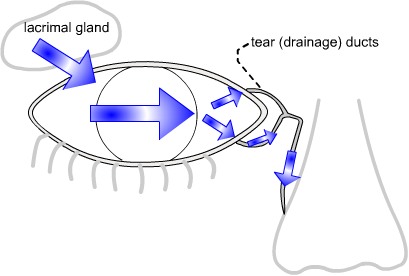Plugs for dry eyes David Kinshuck |
|
| ||||||||||||||||
Dry eyes |
| Dry eyes are caused by a shortage of tears. Normally tears are made in the lacrimal gland, and flow over the front of the eye, into the tear (drainage) ducts. However, but the gland can dry up with age or be damaged by inflammation. Without tears the front of the eye, the cornea, becomes dry. This surface develops tiny 'craters', and these make these eyes feel sore. In severer cases other problems can develop. |
 |
|
Anything that increases the amount of tears will help make the eyes more comfortable. A new treatment is 'plugs'. These fit into the tear ducts and stop the remaining tears draining away. Inserting the plugs takes a few minutes in the clinic. Usually a few anaesthetic drops are used first and you hardly feel anything. Occasionally the entrance to the tear drainage duct has to be widened
first. |
plug in position in RED |
Temporary Plugs |
| These are semi-permanent and dissolve in about 3 months. The plugs are normally very comfortable and cannot be felt. After this the plugs start to dissolve, and the original problem..sore dry eyes...may return. During this 2-3 month period, if your eyes are more comfortable than
they have been, or you need fewer artificial tears, the plugs have
been helpful. Temporary plugs can also be used at times of surgery or other acute eye problems. Normally if you have severely dry eye you will still need artificial tears even if with plugs...but you will need far fewer drops and your eyes should be a lot more comfortable. If the temporary plugs make your eyes water and you have to keep wiping them, then you are probably best without permanent plugs (otherwise you would then have permanently watery eyes). So, 4 weeks after the temporary plugs have been inserted, ask yourself
For some reason many people who have semi-permanent plugs find they can cope better with 'dry eyes' and never need permanent plugs. |
Permanent plugs |
| These can be inserted in a similar way. These plugs can be removed, but it is harder to remove them, and they are designed to be permanent. They would only be removed if they caused trouble such as a very watery eye. Sometimes the plugs can migrate to other parts of the tear duct, perhaps down into the nose, but this is unusual. Plugs make dry eyes more comfortable; occasionally there are problems, such as infections, as here with Smart plugs |
Plugs...complications |
There can be problems with plugs
|
Very dry eyes & preservative free eye drops |
|
Anyone with severely dry eyes, that is dry enough
for plugs, should not really use artificial tears with preservative.
Use drops without preservatives, such as Artificial Tear Minims and
Celluvisc, and there are others for the severest cases. See
this page for more information.
Tear gels such as Viscotears or Lacrilube or simple eye ointment may help patients with severely dry eyes. Drops with preservative will damage the surface of the eye even more. Most people with severely dry eyes will still need to use drops and gel even if they have plugs inserted...but with plugs you may need the drops 4 times/day, as opposed to every 30 minutes without the plugs. In severely dry eyes punctal occlusion is essential, but scarring may cause this naturally. |
|
Types of plugs....for professionals |
Oasis soft: extended duration |
last ~3 months |
| Silicone soft plug | permanent, nice forceps, |
| Smart | see |
| plugs |
|